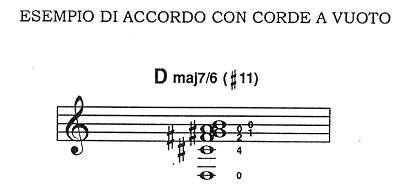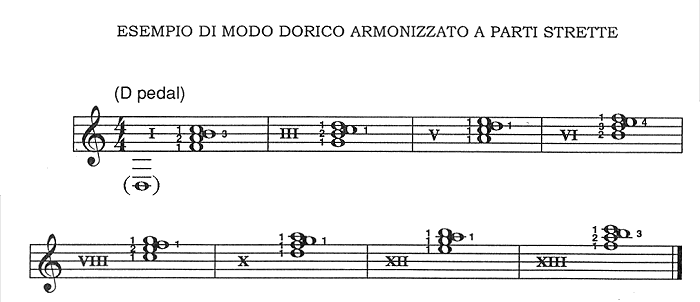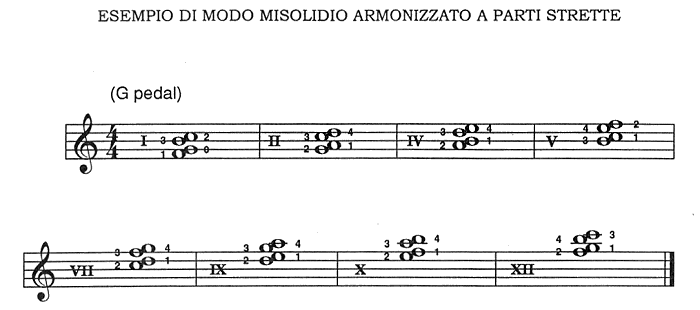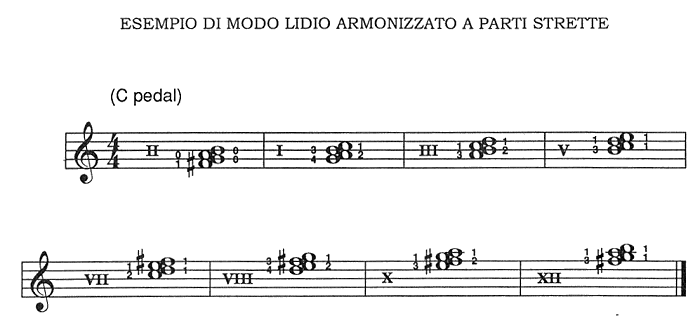[The following lesson is taken from an unpublished booklet
I wrote in Italian and is protected by the Italian Society of Authors and
Editors (S.I.A.E.) as an unpublished work since May 17th 1999].
On July 12, 1995, while I was at the
piano harmonizing some major scale modes four way close -to my ears' pleasure
(especially the Dorian, Myxolydian and Lydian), I was complaining I couldn't do
the same on guitar in spite of my numerous attempts -all failed miserably
because of the actual limits of extension of the human hand-and because, after
all, I compose predominantly on the piano and my compositions are more than
often characterized by harmonies with very close voicings, on that day I started
"detuning" the guitar, or, should I say, modifying its tuning in various ways,
basing myself on the voicings that I usually like best on piano, to explore the
possibility of playing them on guitar. This experiment brought up two results:
the first is the DAEGAB tuning (the notes D, A, E, G, A, B in progressive order
from the sixth to the first string); the second has been the final giving up, on
my behalf, of the tradtional EADGBE tuning (the notes E, A, D, G, B, E). This
way I meant to grab the chance to express myself on guitar in a harmonic idiom
that until then could only be mastered on piano –eccept either by overwhelming
finger stretches or by using a mix of open strings and fretted notes on standard
tuning- (or composing from your desk, as for a horn section, for instance); an
idiom that featured "wide" open voicings (up to six parts) but thick ones, often
containg intervals of a second (up to three simultaneously) without forcing the
guitarist to "thin out" the harmonic texture eccessively, with the use of three
or two-note voicings to be able to highlight chords that imply high harmonic
density (even if that "chord-skimming" can be done by choice, if you like, as
Bill Frisell shows in a wonderful, essential and poetic way).
But anyway it is still a choice which is dictated by the limits of the
instrument, as traditionally tuned.
I'd like to propose this instalment of mine- introductory to the
DAEGAB tuning-to those guitarists, beginners or non, who love close voicings,
but are frustrated by the fact that the guitar does not reciprocate this
harmonic love, forcing them to extend their reach beyond their left hand's
possibility to stretch.
The traditional tuning has undoubtedly a very strong and defined
harmonic personality, made of very stretched, wide-open intervals, but, after
all, it's only a matter of personal taste, and probably those guitarists with
harmonic preferences similar to mine won't consider the DAEGAB as an "open" ore
"alternate" tuning to be utilized occasionally for specific tunes, but more as
an ultimate and definite "harmonic (and melodic!) instrument". I know that
Robert Fripp has already done a similar choice some time ago by adopting a
personal tuning in full and totally in place of the traditional one.
Along these lines, we might get to the day in which the guitar will
speak as many harmonic and melodic idioms as there are guitarists ! Well, maybe
I overdid it a little here ! But maybe one day - possibly in not too distant
time -the circulation of many different guitar tunings- definitively taken on by
as many guitarists, according to their own particular needs of harmony and
expression-will become the normality. And what to say of two guitarists that
play together using different tunings ? I'd say this is a feasible future for
the guitar, or rather..something to look forward to !
So here is a little taste of some possibilities offered by the DAEGAB
tuning; a simple series of demonstrative examples that precedes the publication
of a much more thoroughly examined text, which I'm still working on, diffuse and
complete on the subject, hoping in the meantime that this may interest a good
number of guitarists, no matter what musical style they express themselves
with.

The string gauge and general guitar
setting:
I came up with three ideal string sets: a light
one, a medium and "heavy", which unfortunatly have to be mixed with random
strings:(personally I had some made "out of stock" by Dogal)
Light:.011;.012;.013;.018;.036;.046
Medium: .013;.014;.015;.020;.038;.048
Heavy:
.015;.016;.017;.022;.040;.050
Naturally, the one that plays better is
the" heavy" but it's also very tough under the fingers.
It'll be better to settle again the instrument's balance (truss rod,
action) to adjust it to a string draught of a different intensity and
distribution of weights- compared with the traditional tuning.
At first sight: what changes and what remains the
same.
Two things stay the same: the third and the fifth
string offer the same G and the same A as the traditional tuning; we also have
the same B but on the first string instead of the traditional second; there's
also an interval of an octave between A and A (second and fifth string) instead
of one of two octaves between E and E (1st and 6th string); the highest E string
and the D descend of an octave compared with their range in the traditional
tuning.
As you probably noticed, the notes remain basically the same but are
set (4 out of 6) in a different way, which changes a lot of things but makes it
easy enough to identify the notes on the instrument's fretboard for those
guitarists who had worked a lot in this direction on the traditionally tuned
guitar.
Also take good note of that interval of a perfect fourth between the
4th and the 2nd string and the the one of a major 3rd between the 3rd and the
2nd string: we'd better take advantage of it, since the fingers of a guitarist
who's used to the traditional tuning have a "subconscious" memory which could
show up even if these last 2 intervals are not playable anymore on contiguous
strings.
In short, this tuning offers you the possibility of playing close
voicings harmonies, even perhaps underlined by a McCoyTyner-like fifth in the
bass. Think of having a piano keyboard and hitting simultaineously a perfect
fifth on the bass register with your left hand and a nice four-note cluster
voicing with your right hand. This is what you get most of the time if you
randomly place your left hand on the neck of a DAEGAB- tuned guitar!
From the melodic point of view, on the first 4 strings one can find
arpeggios, unisons, intervals of a second, all at hand; and even an interval of
an octave may be played (between the 4th and the 1st string) in the space of six
frets; while on the last three strings one can play intervals which are even
larger than the ones that are possible on the normally tuned guitar (for example
an interval of a 12th, between the 6th and the 4th string, in the space of 6
frets). The largest interval that may be obtained, between the 6th and the 1st
string, in 6 frets' space, is of a 16th.
The easy performance of unisons within the chords allows the guitar to
play a bit like a lute (with sort of a natural and partial chorus effect)
while, from the melodic viewpoint, makes it very natural to employ repeated
notes (on different strings and even perhaps a little out of sink among
themselves) in the sax-players ' mode rather than pianists'.
The succession of the intervals (from the bass D on) is the following:
perfect fifth; perfect fifth; minor third; major second and major second.
This way a guitar played with all six open strings may give the impression of
a six strings mini-harp, so much that I'm having fun playing some traditional
melodies for japanese koto on it.
Concluding, I find that this tuning in addition provides a valid
alternative composition tool both to the piano and to the regularly tuned
guitar.
Instructional notes for performance on guitar:
- A roman numeral, placed on the staff to the left of the chord, identifies
the position od the index finger on the fretboard; for example VIII = 8th
position, or, if preferred, 8th fret.
- The arabic numerals placed on the staff beside every
single note stand for the fingering (with the left hand) of the chord: 1 =
index finger
(forefinger); 2: middle finger; 3: ring finger; 4 = pinky (little
finger)
When the same number is found beside more than one note, it means we have to
resort to "barre". For instance, in the case of more than one number "1"s, the
"barré" has to be played with the index finger; When a zero (0) appears beside a
note, that note must not be fingered, but played on an open string.
Example of a chord with open strings

File MIDI

Example of how all inversions of a close voicings chord
are all at hand.

File MIDI

Example of a Dorian mode, harmonized with close
voicings

File MIDI

Example of a Myxolydian mode

File MIDI

Example of a Lydian mode, harmonized with close
voicings

File MIDI


